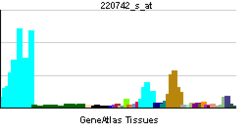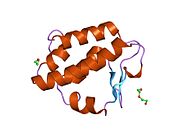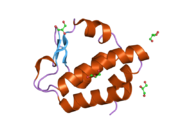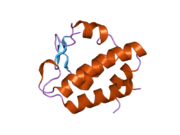- NGLY1
-
N-glycanase 1 
PDB rendering based on 2ccq.Available structures PDB 2CCQ, 2CM0 Identifiers Symbols NGLY1; FLJ11005; FLJ12409; PNG1; PNGase External IDs OMIM: 610661 MGI: 1913276 HomoloGene: 10117 GeneCards: NGLY1 Gene EC number 3.5.1.52 Gene Ontology Molecular function • peptide-N4-(N-acetyl-beta-glucosaminyl)asparagine amidase activity
• protein binding
• hydrolase activity
• metal ion bindingCellular component • cytoplasm Biological process • glycoprotein catabolic process Sources: Amigo / QuickGO RNA expression pattern 
More reference expression data Orthologs Species Human Mouse Entrez 55768 59007 Ensembl ENSG00000151092 ENSMUSG00000021785 UniProt Q96IV0 n/a RefSeq (mRNA) NM_001145293.1 NM_021504.3 RefSeq (protein) NP_001138765.1 NP_067479.2 Location (UCSC) Chr 3:
25.76 – 25.83 MbChr 14:
17.08 – 17.14 MbPubMed search [1] [2] Peptide-N(4)-(N-acetyl-beta-glucosaminyl)asparagine amidase is an enzyme that in humans is encoded by the NGLY1 gene.[1]
References
Further reading
- Suzuki T, Park H, Hollingsworth NM, et al. (2000). "PNG1, a Yeast Gene Encoding a Highly Conserved Peptide:N-Glycanase". J. Cell Biol. 149 (5): 1039–52. doi:10.1083/jcb.149.5.1039. PMC 2174826. PMID 10831608. http://www.pubmedcentral.nih.gov/articlerender.fcgi?tool=pmcentrez&artid=2174826.
- Park H, Suzuki T, Lennarz WJ (2001). "Identification of proteins that interact with mammalian peptide:N-glycanase and implicate this hydrolase in the proteasome-dependent pathway for protein degradation". Proc. Natl. Acad. Sci. U.S.A. 98 (20): 11163–8. doi:10.1073/pnas.201393498. PMC 58701. PMID 11562482. http://www.pubmedcentral.nih.gov/articlerender.fcgi?tool=pmcentrez&artid=58701.
- Strausberg RL, Feingold EA, Grouse LH, et al. (2003). "Generation and initial analysis of more than 15,000 full-length human and mouse cDNA sequences". Proc. Natl. Acad. Sci. U.S.A. 99 (26): 16899–903. doi:10.1073/pnas.242603899. PMC 139241. PMID 12477932. http://www.pubmedcentral.nih.gov/articlerender.fcgi?tool=pmcentrez&artid=139241.
- Ota T, Suzuki Y, Nishikawa T, et al. (2004). "Complete sequencing and characterization of 21,243 full-length human cDNAs". Nat. Genet. 36 (1): 40–5. doi:10.1038/ng1285. PMID 14702039.
- Blom D, Hirsch C, Stern P, et al. (2005). "A glycosylated type I membrane protein becomes cytosolic when peptide: N-glycanase is compromised". EMBO J. 23 (3): 650–8. doi:10.1038/sj.emboj.7600090. PMC 1271816. PMID 14749736. http://www.pubmedcentral.nih.gov/articlerender.fcgi?tool=pmcentrez&artid=1271816.
- Katiyar S, Li G, Lennarz WJ (2004). "A complex between peptide:N-glycanase and two proteasome-linked proteins suggests a mechanism for the degradation of misfolded glycoproteins". Proc. Natl. Acad. Sci. U.S.A. 101 (38): 13774–9. doi:10.1073/pnas.0405663101. PMC 518832. PMID 15358861. http://www.pubmedcentral.nih.gov/articlerender.fcgi?tool=pmcentrez&artid=518832.
- McNeill H, Knebel A, Arthur JS, et al. (2005). "A novel UBA and UBX domain protein that binds polyubiquitin and VCP and is a substrate for SAPKs". Biochem. J. 384 (Pt 2): 391–400. doi:10.1042/BJ20041498. PMC 1134123. PMID 15362974. http://www.pubmedcentral.nih.gov/articlerender.fcgi?tool=pmcentrez&artid=1134123.
- Gerhard DS, Wagner L, Feingold EA, et al. (2004). "The Status, Quality, and Expansion of the NIH Full-Length cDNA Project: The Mammalian Gene Collection (MGC)". Genome Res. 14 (10B): 2121–7. doi:10.1101/gr.2596504. PMC 528928. PMID 15489334. http://www.pubmedcentral.nih.gov/articlerender.fcgi?tool=pmcentrez&artid=528928.
- Misaghi S, Pacold ME, Blom D, et al. (2005). "Using a small molecule inhibitor of peptide: N-glycanase to probe its role in glycoprotein turnover". Chem. Biol. 11 (12): 1677–87. doi:10.1016/j.chembiol.2004.11.010. PMID 15610852.
- Katiyar S, Joshi S, Lennarz WJ (2006). "The Retrotranslocation Protein Derlin-1 Binds Peptide:N-Glycanase to the Endoplasmic Reticulum". Mol. Biol. Cell 16 (10): 4584–94. doi:10.1091/mbc.E05-04-0345. PMC 1237066. PMID 16055502. http://www.pubmedcentral.nih.gov/articlerender.fcgi?tool=pmcentrez&artid=1237066.
- Allen MD, Buchberger A, Bycroft M (2006). "The PUB domain functions as a p97 binding module in human peptide N-glycanase". J. Biol. Chem. 281 (35): 25502–8. doi:10.1074/jbc.M601173200. PMID 16807242.
- Altrich-VanLith ML, Ostankovitch M, Polefrone JM, et al. (2007). "Processing of a class I-restricted epitope from tyrosinase requires peptide N-glycanase and the cooperative action of endoplasmic reticulum aminopeptidase 1 and cytosolic proteases". J. Immunol. 177 (8): 5440–50. PMID 17015730.
PDB gallery 2ccq: THE PUB DOMAIN FUNCTIONS AS A P97 BINDING MODULE IN HUMAN PEPTIDE N-GLYCANASE.2cm0: THE PUB DOMAIN FUNCTIONS AS A P97 BINDING MODULE IN HUMAN PEPTIDE N-GLYCANASE.2d5u: Solution structure of the N-terminal portion of the PUB domain of mouse peptide:N-glycanase2hpj: Crystal structure of the PUB domain of mouse PNGase2hpl: Crystal structure of the mouse p97/PNGase complexCategories:- Human proteins
- Chromosome 3 gene stubs
Wikimedia Foundation. 2010.





